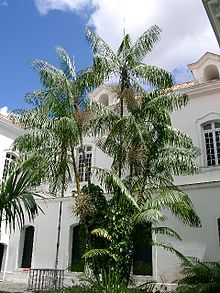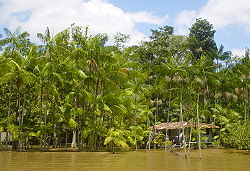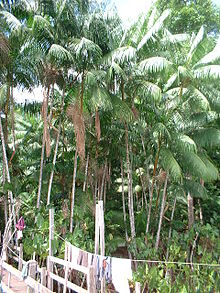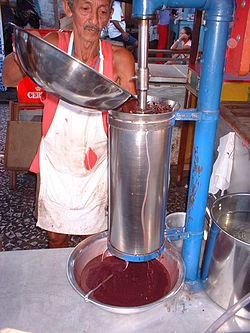- Açaí palm
-
Açaí palm Scientific classification Kingdom: Plantae (unranked): Angiosperms (unranked): Monocots (unranked): Commelinids Order: Arecales Family: Arecaceae Genus: Euterpe Species: E. oleracea Binomial name Euterpe oleracea
Mart.The açaí palm (Portuguese: [aˌsaˈi] (
 listen)) (Euterpe oleracea) is a species of palm tree in the genus Euterpe cultivated for their fruit and superior hearts of palm. Its name comes from the Portuguese adaptation of the Tupian word ïwasa'i, '[fruit that] cries or expels water'. Global demand for the fruit has expanded rapidly in recent years, and açaí is now cultivated for that purpose primarily. The closely related species Euterpe edulis (juçara) is now predominantly used for hearts of palm.[citation needed]
listen)) (Euterpe oleracea) is a species of palm tree in the genus Euterpe cultivated for their fruit and superior hearts of palm. Its name comes from the Portuguese adaptation of the Tupian word ïwasa'i, '[fruit that] cries or expels water'. Global demand for the fruit has expanded rapidly in recent years, and açaí is now cultivated for that purpose primarily. The closely related species Euterpe edulis (juçara) is now predominantly used for hearts of palm.[citation needed]Eight species are native to Central and South America, from Belize southward to Brazil and Peru, growing mainly in swamps and floodplains. Açaí palms are tall, slender palms growing to 15–30 meters, with pinnate leaves up to 3 meters long.
Contents
Harvesting and uses
Fruit
The fruit, a small, round, black-purple drupe about 1 inch (25 mm) in circumference, similar in appearance but smaller than a grape and with less pulp, is produced in branched panicles of 500 to 900 fruits. The exocarp of the ripe fruits is a deep purple color, or green, depending on the kind of açaí and its maturity. The mesocarp is pulpy and thin, with a consistent thickness of 1 mm or less. It surrounds the voluminous and hard endocarp, which contains a single large seed about 0.25–0.40 inches (7–10 mm) in diameter. The seed makes up about 80% of the fruit (Schauss, 2006c). Two crops of fruit are produced each year. The fruits can be harvested and consumed.
In a study of three traditional Caboclo populations in the Brazilian Amazon, açaí palm was described as the most important plant species because the fruit makes up a major component of their diet, up to 42% of the total food intake by weight.[1]
In the northern state of Pará, Brazil, açaí pulp is traditionally served in gourds called "cuias" with tapioca and, depending on the local preference, can be consumed either salty or sweet (sugar, rapadura, and honey are known to be used in the mix). Açaí has become popular in southern Brazil where it is consumed cold as açaí na tigela ("açaí in the bowl"), mostly mixed with granola. Açaí is also consumed in Brazil as an ice cream flavor or juice. The juice has also been used in a flavored liqueur.
Today, a half-dozen brands market açaí in the beverage space.[2] Although most açaí is grown conventionally, the US company Sambazon established USDA Organic certification for their açai palm plantations in 2003 and has also implemented fair trade certification.[3]
In 2005, an article published by Greenpeace International stated that “the tasty dark violet wine of açaí is the most important non-wood forest product in terms of money from the river delta of the Amazon.” [4] In 2008, the Los Angeles Times reported that açaí is a renewable resource that can provide a sustainable livelihood for subsistence harvesters without damaging the Amazon Rainforest. The Times noted that wild harvesting of açaí may contribute to forest preservation and support of harvesting families, thereby making the forest more economical intact rather than cut down. While conventionally grown, monoculture açaí farming is a threat to the rainforest, açaí has been used to successfully reforest already degraded regions.[5] In May 2009, Bloomberg reported that the expanding popularity of açaí in the United States was "depriving Brazilian jungle dwellers of a protein-rich nutrient they’ve relied on for generations."[6]
In the regions of açaí production, such as Pará, açaí palms have replaced sugar cane and other cultivation choices more damaging to the natural environment, such as cattle farming.[citation needed] Such practices indicate that systematic cultivation and reliable commercial supplies may be more prevalent.
Other uses
Apart from the use of its fruit as food or beverage, the açaí palm has other commercial uses. Leaves may be made into hats, mats, baskets, brooms and roof thatch for homes, and trunk wood, resistant to pests, for building construction.[7] Tree trunks may be processed to yield minerals.[8] The palm heart is widely exploited as a delicacy.[9]
Comprising 80% of the fruit mass, açaí seeds may be ground for livestock food or as a component of organic soil for plants. Planted seeds are used for new palm tree stock, which, under the right growing conditions, requires months to form seedlings.[citation needed] The seeds are a source of polyunsaturated and saturated fatty acids[7][10][11]
Nutritional content
A powdered preparation of freeze-dried açaí fruit pulp and skin was reported to contain (per 100 g of dry powder) 533.9 calories, 52.2 g carbohydrates, 8.1 g protein, and 32.5 g total fat. The carbohydrate portion included 44.2 g of dietary fiber and low sugar value (pulp is not sweet).[11] The powder was also shown to contain (per 100 g): negligible vitamin C, 260 mg calcium, 4.4 mg iron, and 1002 U vitamin A, as well as aspartic acid and glutamic acid; the amino acid content was 7.59% of total dry weight (versus 8.1% protein).
The fat content of açaí consists of oleic acid (56.2% of total fats), palmitic acid (24.1%), and linoleic acid (12.5%).[11] Açaí also contains beta-sitosterol (78–91% of total sterols).[11][12] The oil compartments in açaí fruit contain polyphenols such as procyanidin oligomers and vanillic acid, syringic acid, p-hydroxybenzoic acid, protocatechuic acid, and ferulic acid, which were shown to degrade substantially during storage or exposure to heat.[13]
Food product
In the general consumer market, açaí is sold as frozen pulp, juice, or an ingredient in various products from beverages (including the grain alcohol, VeeV), smoothies and foods to cosmetics and supplements.
Dietary supplement
See also: Enforcement actions against açaí berry supplement manufacturersIn 2004, it became popular to consume açaí as a supplement due in part to the rapid success of multi-level marketing company MonaVie that sells an açaí blend tonic for $40 a bottle and the proliferation of various açaí supplement companies that misused celebrity names like Oprah Winfrey and Rachael Ray to promote açaí weight loss pills online.[14]
Marketers of these products make unfounded claims that açaí and its antioxidant qualities provide a variety of health benefits, none of which has scientific confirmation to date. False claims include reversal of diabetes and other chronic illnesses, as well as expanding size of the penis and increasing men's sexual virility and sexual attractiveness to women.[15] As of August 2011, there are no scientifically controlled studies supporting any health benefits from consuming açaí. No açaí products have been evaluated (in the United States) by the FDA, and their efficacy is doubtful.[16] Specifically, there is no scientific evidence that açaí consumption affects body weight, promotes weight loss or has any positive health effect.[17]
According to the Washington, D.C. based Center for Science in the Public Interest (CSPI) thousands of consumers have had trouble stopping recurrent charges on their credit cards when they cancel free trials of açai-based products.[18][19] Even some web sites purporting to warn about açai-related scams are themselves perpetrating scams.[17]
In late 2008, lawyers for The Oprah Winfrey Show began investigating statements from supplement manufacturers who alleged that frequent Oprah guest Dr. Mehmet Oz had recommended their product or açai in general for weight loss.[16]
Polyphenols and antioxidant activity in vitro
A comparative analysis from in vitro studies reported that açaí has intermediate polyphenol content and antioxidant potency among 11 varieties of frozen juice pulps, scoring lower than acerola, mango, strawberry, and grapes.[20]
A powdered preparation of freeze-dried açaí fruit pulp and skin was shown to contain anthocyanins (3.19 mg/g); however, anthocyanins accounted for only about 10% of the overall antioxidant capacity in vitro.[21] The powdered preparation was also reported to contain twelve flavonoid-like compounds, including homoorientin, orientin, taxifolin, deoxyhexose, isovitexin, scoparin, as well as proanthocyanidins (12.89 mg/g), and low levels of resveratrol (1.1 μg/g).[11] A study on another different freeze-dried açaí product (Opti-Acai) reported that the formulation contained much lower levels of anthocyanins, proanthocyanadins, and other polyphenol compounds as compared with blueberries and other antioxidant-rich fruits.[22]
In an in vitro study of different açaí varieties for their antioxidant capacity, a white one displayed no antioxidant activity against different oxygen radicals, whereas the purple variety most often used commercially had antioxidant activity against peroxyl radicals and to a lesser extent peroxynitrite but little activity against hydroxyl radicals.[21]
Freeze-dried açaí powder was found to have antioxidant activity in vitro against superoxide and peroxyl radicals, and mild activity for peroxynitrite and hydroxyl radicals.[22] The powder was reported to inhibit hydrogen peroxide-induced oxidation in neutrophils, and to have a slight stimulatory effect on the reactive radical, nitric oxide.[23]
Extracts of açaí seeds were reported to have antioxidant capacity in vitro against peroxyl radicals, similar to the antioxidant capacity of the pulp, with higher antioxidant capacity against peroxynitrite and hydroxyl radicals.[24]
The anthocyanins of fruit likely have relevance to antioxidant capacity only in the plant's natural defensive mechanisms[25] and in vitro.[26] The Linus Pauling Institute and European Food Safety Authority state that dietary anthocyanins and other flavonoids have little or no direct antioxidant food value following digestion.[27][28][29] Unlike controlled test tube conditions, the fate of anthocyanins in vivo shows they are poorly conserved (less than 5%), with most of what is absorbed existing as chemically modified metabolites destined for rapid excretion.[30]
When the entire scientific literature to date and putative health claims of açaí are assessed, experts concluded in 2011 that the fruit is more a phenomenon of Internet marketing than of scientific substance.[31][32]
Juice blend studies
Various studies have been conducted that analyze the antioxidant capacity of açaí juice blends to pure fruit juices or fruit pulp. Açaí juice blends contain an undisclosed percentage of açaí.
When three commercially available juice mixes containing unspecified percentages of açaí juice were compared for in vitro antioxidant capacity against red wine, tea, six types of pure fruit juice, and pomegranate juice, the average antioxidant capacity was ranked lower than that of pomegranate juice, Concord grape juice, blueberry juice, and red wine. The average was roughly equivalent to that of black cherry or cranberry juice, and was higher than that of orange juice, apple juice, and tea.[33]
A study in 12 healthy fasted human volunteers demonstrated that blood antioxidant capacity was increased within two hours after consumption of a commercial açaí juice beverage or applesauce, but did not investigate any physiological effect of these supposed antioxidants.[34] The generation of reactive oxygen species was not significantly affected by açaí juice consumption.
Quackwatch noted that "açaí juice has only middling levels of antioxidants—less than that of Concord grape, blueberry, and black cherry juices, but more than cranberry, orange, and apple juices." The extent to which polyphenols as dietary antioxidants may promote health is unknown as no credible evidence indicates any antioxidant role for polyphenols in vivo,[35][36] In minute concentrations, polyphenols may affect cell-to-cell signaling, receptor sensitivity, inflammatory enzyme activity or gene regulation.[36][37]
Other research
Freeze-dried açaí powder was shown to have mild inhibitory effects on cyclooxygenase enzymes COX-1 and COX-2,[22] in vitro. Chemically extracted polyphenolic-rich fractions from açaí were reported to reduce the proliferation of HL-60 (experimental leukemia) cells in vitro.[38] In vitro anti-proliferative effects were also observed with extracts from açaí pulp oil.[39]
In a study of rats fed a high cholesterol diet, supplemental feeding with dry açaí pulp reduced blood levels of total and non-high-density lipoprotein cholesterol and superoxide dismutase activity.[40]
Orally administered açaí has been tested as a contrast agent for magnetic resonance imaging of the gastrointestinal system.[41] Its anthocyanins have also been characterized for stability as a natural food coloring agent.[42]
References
- ^ *Murrieta RSS, Dufour DL, Siqueira AD (1999). "Food consumption and subsistence in three Caboclo populations on Marajo Island, Amazonia, Brazil". Human Ecology 27: 455–75. doi:10.1023/A:1018779624490.
- ^ Bounds, Gwendolyn (19 March 2007). "Running the Show". The Wall Street Journal. https://docs.google.com/viewer?url=http://wsjclassroom.com/monday/mx_07mar26.pdf&pli=1.
- ^ Engels, Gayle (2010). "Açaí". HerbalGram, American Botanical Council 86: 1–2. http://cms.herbalgram.org/herbalgram/issue86/article3511.html.
- ^ "Amazon Case Study". http://www.greenpeace.org/international/en/campaigns/forests/solutions/amazon-case-study/. Retrieved 16 September 2005.
- ^ McDonnell, Patrick J. (21 September 2008). "Humble Berry Now a Global Superfood". Los Angeles Times (Los Angeles, CA). http://articles.latimes.com/2008/sep/21/world/fg-acai21.
- ^ "‘Superfood’ Promoted on Oprah’s Site Robs Amazon Poor of Staple". 14 May 2009. http://bloomberg.com/apps/news?pid=20601130&sid=ai8WCgSJrhmY&refer=environment. Retrieved 30 Dec 2009.
- ^ a b Silva, S. & Tassara, H. (2005). Fruit Brazil Fruit. São Paulo, Brazil, Empresa das Artes
- ^ Dyer, A. P. 1996. Latent energy in Euterpe oleracea. Biomass Energy Environ., Proc. Bioenergy Conf. 9th.
- ^ "Açaí Fruit". http://www.rain-tree.com/acai.htm. Retrieved 2010-04-21.
- ^ Plotkin MJ, Balick MJ (Apr 1984). "Medicinal uses of South American palms". J Ethnopharmacol 10 (2): 157–79. doi:10.1016/0378-8741(84)90001-1. PMID 6727398.
- ^ a b c d e Schauss AG, Wu X, Prior RL, Ou B, Patel D, Huang D, Kababick JP (2006). "Phytochemical and nutrient composition of the freeze-dried amazonian palmberry, Euterpe oleraceae Mart. (acai)". J Agric Food Chem 54 (22): 8598–603. doi:10.1021/jf060976g. PMID 17061839.
- ^ Lubrano C, Robin JR, Khaiat A (1994). "Fatty-acid, sterol and tocopherol composition of oil from the fruit mesocarp of 6 palm species in French-Guiana". Oleagineux 49: 59–6.
- ^ Pacheco-Palencia LA, Mertens-Talcott S, Talcott ST (Jun 2008). "Chemical composition, antioxidant properties, and thermal stability of a phytochemical enriched oil from Açaí (Euterpe oleracea Mart.)". J Agric Food Chem. 56 (12): 4631–6. doi:10.1021/jf800161u. PMID 18522407.
- ^ Ellin, Abbey (12 March 2009). "Pressing Açaí for Answers". The New York Times.
- ^ "Reality check"
- ^ a b Susan Donaldson James. "'Superfood' Açaí May not Be Worth Price: Oprah's Dr. Oz Says Açai Is Healthy but No Cure-all; Dieter Feels Ripped Off", ABC News, December 12, 2008. Retrieved Dec. 30, 2008.
- ^ a b http://www.quackwatch.com/01QuackeryRelatedTopics/PhonyAds/acai.html
- ^ "Oprah is coming after bad Internet Marketers". Adotas. http://www.adotas.com/2009/08/oprah-is-coming-after-bad-internet-marketers/.
- ^ "AG warns about deceptive weight loss supplement offer". King5 News. http://www.king5.com/localnews/stories/NW_082609WAB-acai-berry-offer-warning-TP.1261bd61e.html. Retrieved 2009-09-09.[dead link]
- ^ Kuskoski EM, Asuero AG, Morales MT, Fett R (2006). "Wild fruits and pulps of frozen fruits: antioxidant activity, polyphenols and anthocyanins". Cienc Rural 36 (4 (July/Aug)). doi:10.1590/S0103-84782006000400037. http://www.scielo.br/scielo.php?script=sci_arttext&pid=S0103-84782006000400037&lng=en&nrm=iso.
- ^ a b Lichtenthäler R, Rodrigues RB, Maia JG, Papagiannopoulos M, Fabricius H, Marx F (Feb 2005). "Total oxidant scavenging capacities of Euterpe oleracea Mart. (Açaí) fruits". Int J Food Sci Nutr 56 (1): 53–64. doi:10.1080/09637480500082082. PMID 16019315.
- ^ a b c Schauss A.G., Wu X., Prior R.L., Ou B., Huang D., Owens J., Agarwal A., Jensen G.S., Hart A.N., Shanbrom E. (2006). "Antioxidant capacity and other bioactivities of the freeze-dried amazonian palm berry, Euterpe oleraceae Mart. (acai)". J Agric Food Chem 54 (22): 8604–10. doi:10.1021/jf0609779. PMID 17061840.
- ^ Alexander G.Schauss et al. "Antioxidant Capacity and Other Bioactivities of the Freeze-Dried Amazonian Palm Berry, Euterpe oleraceae Mart. (Acai)", J. Agric. Food Chem. 54(2006)8604-8610. downloaded November 20, 2010, from http://pubs.acs.org/doi/pdf/10.1021/jf0609779
- ^ Rodrigues RB, Lichtenthäler R, Zimmermann BF, et al. (Jun 2006). "Total oxidant scavenging capacity of Euterpe oleracea Mart. (açaí) seeds and identification of their polyphenolic compounds". J Agric Food Chem. 54 (12): 4162–7. doi:10.1021/jf058169p. PMID 16756342.
- ^ Simon PW (1997). "Plant Pigments for Color and Nutrition". http://www.hort.wisc.edu/usdavcru/simon/publications/97hort0012.html.
- ^ De Rosso VV, Morán Vieyra FE, Mercadante AZ, Borsarelli CD (October 2008). "Singlet oxygen quenching by anthocyanin's flavylium cations". Free Radical Research 42 (10): 885–91. doi:10.1080/10715760802506349. PMID 18985487.
- ^ Lotito SB, Frei B (2006). "Consumption of flavonoid-rich foods and increased plasma antioxidant capacity in humans: cause, consequence, or epiphenomenon?". Free Radic. Biol. Med. 41 (12): 1727–46. doi:10.1016/j.freeradbiomed.2006.04.033. PMID 17157175.
- ^ Williams RJ, Spencer JP, Rice-Evans C (April 2004). "Flavonoids: antioxidants or signalling molecules?". Free Radical Biology & Medicine 36 (7): 838–49. doi:10.1016/j.freeradbiomed.2004.01.001. PMID 15019969.
- ^ Scientific Opinion on the substantiation of health claims related to various food(s)/food constituent(s) and protection of cells from premature aging, antioxidant activity, antioxidant content and antioxidant properties, and protection of DNA, proteins and lipids from oxidative damage pursuant to Article 13(1) of Regulation (EC) No 1924/20061, EFSA Panel on Dietetic Products, Nutrition and Allergies (NDA)2, 3 European Food Safety Authority (EFSA), Parma, Italy, EFSA Journal 2010; 8(2):1489
- ^ "Studies force new view on biology of flavonoids", by David Stauth, EurekAlert!. Adapted from a news release issued by Oregon State University
- ^ Heinrich M, Dhanjia T, Casselman I (2011). "Açai (Euterpe oleracea Mart.) — A phytochemical and pharmacological assessment of the species’ health claims". Phytochem Lett 4 (3): 10–21. doi:10.1016/j.phytol.2010.11.005.
- ^ "‘Insufficient and unconvincing’ scientific evidence to promote acai, says review". NutraIngredients-USA.com, Mar 16, 2011. http://www.nutraingredients-usa.com/Research/Insufficient-and-unconvincing-scientific-evidence-to-promote-acai-says-review/?c=7InNqGv0AjdeP5cI9Z%2BAZg%3D%3D&utm_source=newsletter_daily&utm_medium=email&utm_campaign=Newsletter%2BDaily. Retrieved 2011-04-03.
- ^ Seeram NP, Aviram M, Zhang Y, et al. (Feb 2008). "Comparison of antioxidant potency of commonly consumed polyphenol-rich beverages in the United States". J Agric Food Chem. 56 (4): 1415–22. doi:10.1021/jf073035s. PMID 18220345.
Reprint at Pom Wonderful - ^ Mertens-Talcott SU, Rios J, Jilma-Stohlawetz P, et al. (Sep 2008). "Pharmacokinetics of anthocyanins and antioxidant effects after the consumption of anthocyanin-rich açaí juice and pulp (Euterpe oleracea Mart.) in human healthy volunteers". J Agric Food Chem. 56 (17): 7796–802. doi:10.1021/jf8007037. PMID 18693743.
- ^ Williams RJ, Spencer JP, Rice-Evans C (April 2004). "Flavonoids: antioxidants or signalling molecules?". Free Radical Biology & Medicine 36 (7): 838–49. doi:10.1016/j.freeradbiomed.2004.01.001. PMID 15019969.
- ^ a b Frei B. "Controversy: What are the true biological functions of superfruit antioxidants?". http://www.npicenter.com/anm/templates/newsATemp.aspx?articleid=23667&zoneid=273. Retrieved February 5, 2010.[dead link]
- ^ Virgili F, Marino M (November 2008). "Regulation of cellular signals from nutritional molecules: a specific role for phytochemicals, beyond antioxidant activity". Free Radical Biology & Medicine 45 (9): 1205–16. doi:10.1016/j.freeradbiomed.2008.08.001. PMID 18762244.
- ^ Del Pozo-Insfran D, Percival SS, Talcott ST (Feb 2006). "Açai (Euterpe oleracea Mart.) polyphenolics in their glycoside and aglycone forms induce apoptosis of HL-60 leukemia cells". J Agric Food Chem. 54 (4): 1222–9. doi:10.1021/jf052132n. PMID 16478240.
- ^ Pacheco-Palencia LA, Talcott ST, Safe S, Mertens-Talcott S (May 2008). "Absorption and biological activity of phytochemical-rich extracts from açai (Euterpe oleracea Mart.) pulp and oil in vitro". J Agric Food Chem. 56 (10): 3593–600. doi:10.1021/jf8001608. PMID 18442253.
- ^ Oliveira de Souza M, Silva M, Silva ME, de Paula Oliveira R, Pedrosa ML. (Dec 17 2009). "Diet supplementation with açaí (Euterpe oleracea Mart.) pulp improves biomarkers of oxidative stress and the serum lipid profile in rats.". Nutrition 26 (7-8): 804–10. doi:10.1016/j.nut.2009.09.007. PMID 20022468.
- ^ Córdova-Fraga T, de Araujo DB, Sanchez TA, et al. (Apr 2004). "Euterpe Olerácea (Açaí) as an alternative oral contrast agent in MRI of the gastrointestinal system: preliminary results". Magn Reson Imaging 22 (3): 389–93. doi:10.1016/j.mri.2004.01.018. PMID 15062934.
- ^ Del Pozo-Insfran D, Brenes CH, Talcott ST (Mar 2004). "Phytochemical composition and pigment stability of Açaí (Euterpe oleracea Mart.)". J Agric Food Chem. 52 (6): 1539–45. doi:10.1021/jf035189n. PMID 15030208.
Further reading
- Craft P, Riffle RL (2003). An encyclopedia of cultivated palms. Portland, Oregon, United States: Timber Press. ISBN 0-88192-558-6.
See also
- Environment of Brazil
- List of plants of Amazon Rainforest vegetation of Brazil
- Açaí oil
- Ver-o-peso
External links
- Pictures of açaí palms trees and fruit from an article by The Nature Conservancy.
Wikimedia Foundation. 2010.





